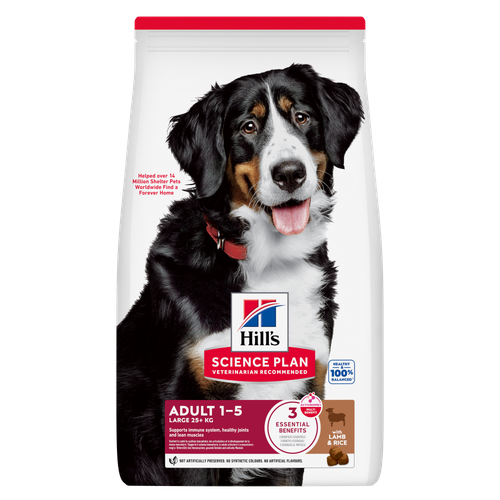
-
Find the right food for your petTake this quiz to see which food may be the best for your furry friend.Find the right food for your petTake this quiz to see which food may be the best for your furry friend.Featured products
 Perfect Digestion Small & Mini Adult Dog Food
Perfect Digestion Small & Mini Adult Dog FoodHill's Science Plan Perfect Digestion Small & Mini Breed Adult Dog Food with Chicken & Brown Rice supports ultimate digestive well-being & a healthy microbiome.
Shop Now Small & Mini Mature Adult 7+ Dog Food
Small & Mini Mature Adult 7+ Dog FoodHill's Science Plan Small & Mini Breed Mature Adult Dog Food with Chicken is a complete pet food, specially formulated with ActivBiome+ Multi-Benefit Technology.
Tailored nutrition to support graceful ageing in small dogs. Specially made with a synergistic blend of nutrients for energy & vigor.Shop Now Perfect Digestion Large Breed Puppy Food
Perfect Digestion Large Breed Puppy FoodPrecisely balanced nutrition with Hill's ActivBiome+ prebiotic blend actively contributes to supporting digestive health and overall well-being to help your pet feel their best
Shop NowFeatured products Hypoallergenic Dry Cat Food
Hypoallergenic Dry Cat FoodHILL'S SCIENCE PLAN Hypoallergenic Adult cat food with egg & insect protein is a complete pet food for adult cat 1–6 years old. It's formulated for cats with delicate skin and stomach, with limited high quality novel protein sources & no grain.
Shop Now Kitten Food
Kitten FoodTender chicken chunks in gravy for kittens, with omega-3s for healthy eye & brain development and high-quality protein to support muscle growth. With balanced minerals to promote strong bones & teeth.
Shop Now Hairball & Perfect Coat Adult Cat Food
Hairball & Perfect Coat Adult Cat FoodHill's Science Plan HAIRBALL & PERFECT COAT Adult cat food with Chicken is specially formulated to effectively help avoid hairball formation in adult cats while promoting a beautiful coat. Thanks to its mix of essential Omega-6 fatty acids, this food benefits the cat's skin and fur keeping them healthy and shiny. Our Advanced Fibre Technology helps reduce hairballs by naturally promoting their passage through the gut. This food is formulated with high-quality protein for a perfectly balanced, great-tasting recipe.
Shop Now -
Dog
- Dog Tips & Articles
-
Health Category
- Weight
- Food & Environmental Sensitivities
- Urinary
- Digestive
- Joint
- Kidney
-
Life Stage
- Puppy Nutrition
- Adult Nutrition
- Senior Nutrition
Cat- Cat Tips & Articles
-
Health Category
- Weight
- Skin & Food Sensitivities
- Urinary
- Digestive
- Kidney
-
Life Stage
- Kitten Nutrition
- Adult Nutrition
Featured articles The Right Diet For Your Pet
The Right Diet For Your PetLearn what to look for in healthy pet food & nutrition, including ingredients, quality of the manufacturer, your pet's age, and any special needs they have
Read More Pet Food Storage Tips
Pet Food Storage TipsWhere you store your cat and dog food can make a big difference in the quality and freshness once it is opened. Here are some common questions and recommendations for optimal storage for all of Hill’s dry and canned cat and dog food.
Read More Understanding Your Pet's Microbiome
Understanding Your Pet's MicrobiomeLearn what a pet's microbiome is, how it contributes to your pet's gut & overall health, and why nutrition is important in maintaining healthy microbiomes.
Read More -


Adopting a dog can be overwhelming if you don't know where to begin, but bringing home a pup is also fun and exciting! This milestone is the first bonding moment of many between you and your new furry friend. To help ease that stress, here are ten things you can do to ensure a smooth transition for everyone.
1. Gather Their Supplies
Get everything you'll need to make them safe and comfortable before bringing them home. In addition to the basics—a collar and leash, as well as food and water bowls—you'll also need a dog bed, pet gate, toys, treats, and grooming supplies. It's also a good idea to have training pads and enzymatic cleaner on hand for accidents in the early stages of house-training.
2. Prepare Your Home
Similar to babyproofing, it's always a smart and safe idea to ready your space before your pup comes home. Walk through your home and stow away items that might be harmful to small for overly curious pups, and pick up those items you don't want to get chewed.
You should prepare the rest of the family too: Discuss which family members will take up feeding, walking, and training. If other animals already live at home, be sure their shots are up-to-date and that the whole family has been dewormed, for everyone's safety. And if you have any cats, you should have a designated dog-free area where they can retreat, giving them a way to acclimate to the new arrival's excitement on their own time. This may seem like overkill to some, but this preparation helps keep your pooch safe and eases everyone's transition process.
3. Assign a Safe Space for Them
Just as you would for existing pets, make the same private space for your new one. Some pet parents have an aversion to dog crates, but the nonprofit Best Friends holds that dogs actually see them as their own room to rest, much like a den. They also serve as a place to feel safe while they adjust. If you'd prefer not to use a crate, of course, use a pet gate to block off a room just for them. You can visit them there to help the bonding process, but keep kids and other pets out for the time being.


Tasty Tips
4. Plan How (and When) to Bring Them Home
If possible, take a few days off work or plan to pick your dog up on a weekend when you have free time. But don't pick them up at the beginning of a holiday period; if they get used to you constantly being home, they can develop separation anxiety when you go back to work. Have someone else drive you to pick them up, or ride along to help comfort them while you drive. Don't forget to take their collar and leash, and bring them straight home without making any distracting stops.
Ensure that you plan a quiet few days at home when your new pet arrives. Although your family and friends are dying to meet your new family member, hold off until your dog is settled.
5. Show Your Dog around the House
Let them explore and sniff on their own time. Show them where their bed, toys and water is. Ensure that you are able to prevent them from going to off limits areas and no go items.
6. Explore the Garden
Adopted dogs should have plenty of time and space to sniff out their new surroundings. If you've designated a potty space in your garden, lead them to it and reward them with a treat when they use it successfully.
7. Introduce the Family
It is recommended to bring family members and other dogs outside in a relatively neutral area, one at a time, to meet the new addition. Try to keep introductions low key, allowing them to get used to each other from a distance before introducing.. Interactions also do not have to happen on the first day. You can give them visual and scenting access without them being able to physically meet which will allow them to get used to each other over time. Keep other dogs on their leashes and supervise their interactions. Restrain kids (and other parents) from kissing or hugging the dog (however adorable they may be), but they're free to make friends with a sniff and a treat.
8. Switch Your Dog's Food Slowly
If you can, incorporate some of the food the shelter or breeder was feeding him, and gradually switch your dog's food to the brand you intend to serve him regularly in order to avoid digestion issues due to too quick a change.
9. Begin Training Right Away
Even adult dogs who were previously house trained will require a little retraining.. If you plan to crate train your dog, introduce them to their crate right away, and practice allowing them access to the crate —with a toy or chew—for short periods without closing the door.. Puppies should be taken to Puppy School and adults to classes to ensure that your dog fits into society without a problem. You will also learn how to establish rules through consistency and positive reinforcement.
10. Get Them Checked by a Vet
Within a week of bringing them home, you should visit a veterinarian for a health check and to make sure they have all their vaccinations.
Adopting a dog is a big transition for both the dog and your family. Covering these basics will help your new dog feel secure in their new surroundings and make it easier to bond with your new wet-nosed pal.


Jean Marie Bauhaus is a pet parent, pet blogger, and novelist from Tulsa, Oklahoma, where she usually writes under the supervision of a lapful of fur babies.
Related products

Hill's Science Plan Large Breed Adult Dog Food with Lamb & Rice is a complete pet food, specially formulated with ActivBiome+ Multi-Benefit Technology.
This food is specifically designed to fuel the energy needs of large breed dogs during the prime of their life.

Precisely balanced nutrition with Hill's ActivBiome+ prebiotic blend actively contributes to supporting digestive health and overall well-being to help your pet feel their best

Hill's Science Plan Small & Mini Breed Mature Adult Dog Food with Chicken is a complete pet food, specially formulated with ActivBiome+ Multi-Benefit Technology.
Tailored nutrition to support graceful ageing in small dogs. Specially made with a synergistic blend of nutrients for energy & vigor.

Hill's Science Plan Perfect Digestion Small & Mini Breed Adult Dog Food with Chicken & Brown Rice supports ultimate digestive well-being & a healthy microbiome.
Related articles

Dog obesity is a significant problem - learn more about helping your dog become trimmer and healthier through improved nutrition.

Learn about snake bites on dogs, including clinical symptoms to look for, what to do if you think your dog was bitten, and treatment & prevention options.

Discover how the field of dog science is giving us more and more insights into the inner workings of our furry best friends.

Discover the causes, signs, and treatments of kidney disease in dogs and find methods of supporting your dog's kidney health. Learn more at Hill's Pet South Africa.

Put your dog on a diet without them knowing
Our low calorie formula helps you control your dog's weight. It's packed with high-quality protein for building lean muscles, and made with purposeful ingredients for a flavorful, nutritious meal. Clinically proven antioxidants, Vitamin C+E, help promote a healthy immune system.
Put your dog on a diet without them knowing
Our low calorie formula helps you control your dog's weight. It's packed with high-quality protein for building lean muscles, and made with purposeful ingredients for a flavorful, nutritious meal. Clinically proven antioxidants, Vitamin C+E, help promote a healthy immune system.

